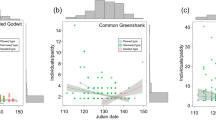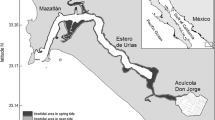Abstract
The distribution of North American redheads (Aythya americana) during winter is highly concentrated in the Laguna Madre of Texas and Tamaulipas, Mexico. Redheads forage almost exclusively in the lagoon and primarily on shoalgrass (Halodule wrightii) rhizomes; however, they make frequent flights to adjacent coastal ponds to dilute salt loads ingested while foraging. We conducted 63 weekly aerial surveys during October–March 2000–2003 to record use of coastal ponds by redheads. We collected information from used and unused coastal ponds to better understand factors selected by redheads for their dietary fresh water requirements. Coastal ponds used by redheads had greater surface area, percent open water, average depth, and turbidity than unused coastal ponds. Similarly, redheads used coastal ponds with lower salinity and ammonia concentrations than unused ponds. Redheads were observed on coastal ponds >6 km from foraging areas on 95% of surveys during dry conditions in 2000–01, compared to 43% of surveys during moderately wet conditions in 2001–02 and 5% during very wet conditions in 2002–03. Finally, our data suggests that redheads rely on dietary freshwater sources throughout winter and do not reduce visitation to these coastal ponds as winter progresses.

Similar content being viewed by others
References
Adair SE (1990) Factors influencing wintering diving duck use of coastal ponds in south Texas. M.S. Thesis, Texas A&M University, College Station, p 210
Adair SE, Moore JL, Kiel WH Jr (1996) Winter diving duck use of coastal ponds: an analyses of alternative hypotheses. Journal of Wildlife Management 60:83–93
Allison PD (1999) Logistic regression using the SAS system: theory and application. SAS Institute Inc., Carey
Bennett DC, Hughes MR (2003) Comparison of renal and salt gland function in three species of wild ducks. Journal of Experimental Biology 206:3273–3284
Brown LF Jr, McGowen JH, Evans TJ, Groat CG, Fisher WL (1977) Environmental geological atlas of the Texas coastal zone-Kingsville area. Bureau of Econimic Geology, University of Texas, Austin
Cornelius SE (1982) Wetland salinity and salt gland size in the redhead Aythya americana. The Auk 99:774–778
Custer CM, Custer TW, Zwank PJ (1997) Migration chronology and distribution of redheads on the lower Laguna Madre, Texas. Southwestern Naturalist 42:40–51
Diggle PJ, Liang KY, Zeger SL (1994) The analysis of longitudinal data. Oxford University Press, New York
Fulbright TE, Diamond DD, Rappole J, Norwine J (1990) The coastal sand plain of south Texas. Rangelands 12:337–340
James JD (2006) Utilization of shoalgrass resources and nutritional ecology of wintering redheads in the Laguna Madre of Texas. Ph.D. Dissertation. Texas A&M University-Kingsville, p 117
Kiel WH Jr (1957) Coastal waterfowl survey: ecology of wintering waterfowl in the lower Laguna Madre. Texas Parks and Wildlife Department Federal Aid Project W-29-R-10. Job 16, p 24
McAdams MS (1987) Classification and waterfowl use of ponds in south Texas. M. S. thesis. Texas A&M University, College Station
McMahan CA (1968) Biomass and salinity tolerances of shoalgrass and manateegrass in lower Laguna Madre, Texas. Journal of Wildlife Management 32:501–506
Michot TC (2000) Comparison of wintering redhead populations in four Gulf of Mexico seagrass beds. In: Comin FA, Herrera JA, Ramirez J (eds) Limnology and aquatic birds: monitoring, modeling and management. Universidad Autonoma de Yucatan, Merida, pp 243–260
Michot TC, Woodin MC, Adair SE, Moser EB (2006) Diurnal time activity budgets of redheads (Aythya Americana) wintering in seagrass beds and coastal ponds in Louisiana and Texas. Hydrobiologia 576:113–128
Michot TC, Woodin MC, Nault AJ (2008) Food habits of redheads (Aythya Americana) wintering in seagrass beds of coastal Louisiana and Texas, USA. Acta Zoologica Academiae Scientiarum Hungaricae 54(suppl 1):239–250
Mitchell CA, Custer TW, Zwank PJ (1992) Redhead duck behavior on lower Laguna Madre and adjacent ponds of southern Texas. The Southwestern Naturalist 37:65–72
Quammen ML, Onuf CP (1993) Laguna Madre: seagrass changes continue decades after salinity reduction. Estuaries 16:302–310
SAS Institute, Inc. (2001) SAS Release 8.1. SAS Institute, Inc., Cary, North Carolina, USA
Schmidt-Nielsen K, Kim YT (1964) The effect of salt intake on the size and function of the salt gland of ducks. Auk 81:160–172
Skoruppa MK, Woodin MC (2000) Impact of wintering redhead ducks on pond water quality in southern Texas. In: Comin FA, Herrera JA, Ramirez J (eds) Limnology and aquatic birds: monitoring, modeling and management. Universidad Autonoma de Yucatan, Merida, pp 31–41
Texas Parks and Wildlife Department (1999) Seagrass conservation plan for Texas. Texas Parks and Wildlife, Austin
Tunnel JW (2002) Geography, climate, and hydrology. In: Tunnel JW, Judd FW (eds) The Laguna Madre of Texas and Tamaulipas. Texas A&M University Press, College Station, pp 7–27
U.S. Environmental Protection Agency (USEPA) (1983) Methods for chemical analyses of water and waste. Manual #EPA-600/4-79-020, Washington, D.C., USA
U.S. Fish and Wildlife Service (2004) Analyses of selected mid-winter waterfowl survey data (1955–2004); Region 2 (Central Flyway portion). U.S. Fish and Wildlife Service, Albuquerque
Weller MW (1964) Distribution and migration of the redhead. Journal of Wildlife Management 28:64–103
Woodin MC (1994) Use of saltwater and freshwater habitats by wintering redheads in southern Texas. Hydrobiologia 279/280:279–287
Acknowledgements
Support for this research was provided by Ducks Unlimited, Inc. through the Southern Regional Office, the Alvin and Lucy Owsley Foundation, Coastal Bend Bays and Estuaries Program, and Texas Coastal Management Program for funding and in-kind support. We thank J. Davis and A. Windham for field assistance. We greatly appreciate the King Ranch Inc., and Kenedy Ranch for allowing access to their properties. This is manuscript #07-106 of the Caesar Kleberg Wildlife Research Institute.
Author information
Authors and Affiliations
Corresponding author
Rights and permissions
About this article
Cite this article
Ballard, B.M., Dale James, J., Bingham, R.L. et al. Coastal Pond Use by Redheads Wintering in the Laguna Madre, Texas. Wetlands 30, 669–674 (2010). https://doi.org/10.1007/s13157-010-0076-0
Received:
Accepted:
Published:
Issue Date:
DOI: https://doi.org/10.1007/s13157-010-0076-0




